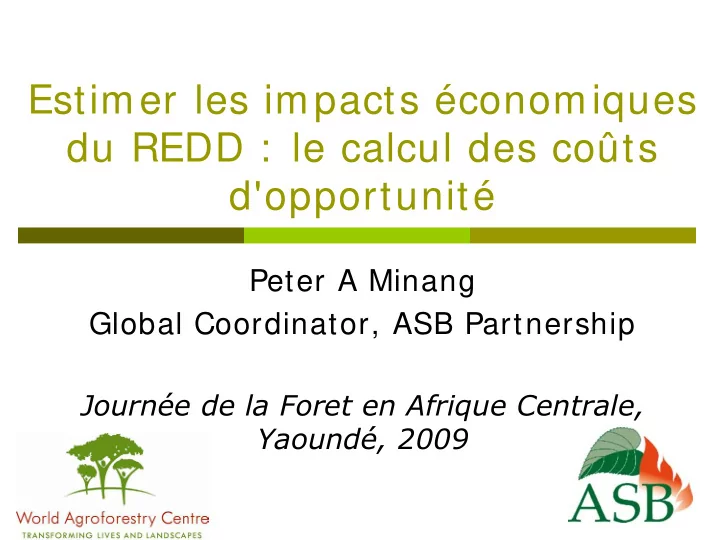

Estimer les impacts économiques du REDD : le calcul des coûts d'opportunité Peter A Minang Global Coordinator, ASB Partnership Journée de la Foret en Afrique Centrale, Yaoundé, 2009
What costs and Benefits Costs Benefits Opportunity costs Carbon / Climate (Opportunities forgone/ as benefits a results of not doing something) Implementation costs Biodiversity (Policies, etc) Transaction Costs Monetary (MRV, etc) Water Benefits
When to do opportunity costs analysis?
Benchmark of southern Cameroon strong north-south population and resource use gradient 1.5 Mha Two study sites: - Awae - Akok
Method Remote sensing data interpretation Time series at pixel and spatial analysis level LULC Land use/ cover C Time-averaged C-stock matri C-stock of ∆ time - Land use/ Net present x land use cover averaged value systems Time C-stock= C-stock 1 Private and CO 2 Net present value social emission Time profitability: Net 2 ∆ NPV= Present Value of economic land use gain NPV before - NPV after 3.67 in $ / t * Cstock after - CO 2 eq Cstock
Land use systems • Two forest systems high forest, secondary forest • Three agroforestry / tree crop systems extensive cocoa extensive cocoa with fruit intensive cocoa with fruit • Two fallow / mixed landscape mosaics mixed food crop / short fallow melon-seed / plantain / long fallow
Time-averaged C Stocks Time-averaged carbon stock Time-averaged total system carbon in land uses 300 = C-accumulation rate * C-residence time Carbon (mgha -1 ) 200 Yaounde = average C-stock Mbalmayo Ebolowa 100 over the life cycle = average over a 0 Old fallow Mature plantation Young Farmland secondary fallow forest Cocoa Young forest landscape mosaic of all phases (if system is Land use class stable)
C-stock & NPV_priv of land uses Time-averaged C-stock NPV_priv Land Uses: Mg/ha $/ha high forest 250 309 secondary forest 200 128 extensive cocoa (only Akok) 141 7,096 extensive cocoa w/fruit (only Awae) 141 21,192 intensive cocoa w/fruit (only Awae) 141 28,489 5 7,203 mixed food crop field/short fallow rotation melon-seed/plantain/long fallow rotation 63 10,879
Carbon emissions abatement supply curve for Awae - a carbon emitting site 80 75% of 70 emissions at 4 60 Abatement costs, $/ t CO2-eq/ ha $/ t of CO2-eq 50 40 30 Abatement costs, $/ t CO2-eq 20 10 0 -20 0 20 40 60 80 100 -10 -20 Cumulative net emissions, t CO2- Cumulative net emissions, t CO2-eq/ha eq/ ha
Beware: Trade-offs (biodiversity / profitability etc
Findings / Conclusions • About 80% of emitting land-use changes in the study areas since 1990 could have been offset by payments of less than $5 / tonne. • Agroforestry and intermediate land uses offer best opportunities for meeting C, biodiversity, and poverty alleviation benefits • Prospective studies needed as Future opportunity costs will depend on REDD incentives and land-use incentives , Price etc. • Understanding cost and benefits in totality would require extensive research in our countries as current estimates of other costs remain coarse
MERCI / THANK YOU See Swallow et al, 2007 and Robliglio, 2007 for details www.asb.cgiar.org
Recommend
More recommend